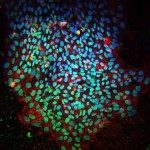Link to Pubmed [PMID] – 8928226
Trends Genet 1996 Jun; 12(6): 218-23
Skeletal myoblasts are derived from paraxial mesoderm, but how myoblasts acquire their identity is still a matter of speculation. The characterization of molecular markers and, in some cases, the analysis of mutations in the corresponding genes, has now made it possible to ask specific questions about this process. Specification of somite cell fate depends on epigenetic factors. Adjacent tissues, such as the neural tube, notochord, dorsal ectoderm and lateral mesoderm, act either positively or negatively on the different myogenic precursor populations in the somite. Candidate molecules for this complex signalling activity include sonic hedgehog and the Wnt proteins as positive signals, and BMP4 as a possible inhibitor. Although it is generally assumed that induction is required, some observations suggest that embryonic cells might have a tendency to undergo myogenesis as a ‘default’ pathway. By analogy with Drosophila, where the neurogenic genes affect myogenesis, the vertebrate homologues of notch and its ligands could be candidate molecules for a repression or derepression mechanism. Similar studies with cultured muscle cells also implicate other HLH factors as potential inhibitors of the MyoD family and, hence, of inappropriate myogenesis.


